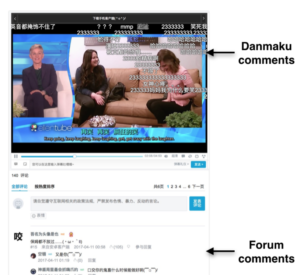- Thomas Erickson and Wendy A. Kellogg. “Social Translucence: An Approach to Designing Systems that Support Social Processes”
- Judith Donath and Fernanda B. Viégas. “The Chat Circles Series: Explorations in Designing Abstract Graphical Comm. Interfaces”
Both papers contribute towards design rationale for social system design, and what role these systems play in fostering communication and collaboration. They both argue for the need for implementing social cues that take lessons from social information and applying it to the online discourse. Erickson argues with their glass door metaphor that this use leads to other, less visible transfer of mores: visibility, awareness and accountability.
Donath’s paper considered the designs such as those discussed by Erickson and articulated what users consider important, and affordances that carry over from socializing in the physical world and onto the online world (in agreement with the same concept of how to use social cues outside the physical context by Erickson).
The text-based chat system described by both papers (described by Erickson as an “abstract” communication) can be considered an egg-version of a much mature Whatsapp functionality that allows interactions between groups, a user moving between groups, the “proximity” giving access to information and the “exit” visible (giving rise to the consideration of what etiquette to follow when exiting). The audio circle described by Donath — and the visual cues it gives to observers/participants is reminiscent of Google Hangout implementation that shows the volume change via the audio bar and also serving as a pin-point on the active speaker. Tele-actor and tele-direction, also presented by Donath, while does not have a direct equivalent, is reminiscent of the Danmaku commenting system. And while indirectly impacting a user’s action is ethically iffy, there are other, less intrusive approaches that may consider this, such as the use of Petcube app as a means to remotely control a live cat laser while donating for a cause.

The constraints binding the discourse and in negotiating etiquette in discussion groups reveals the tensions between privacy and visibility using these themes as cues we consider the present social systems design environment
Bounds:
Who benefits from the erasure of boundaries? There is the thinnest of boundaries between social lives across the different social media. It’s a common practice for companies to create presence on all major platforms, targeting users in different ways unique to the platforms (that provide specific services). Facebook acquiring both Whatsapp and Instagram is another such boundary erasure example. Assuming the boundaries still exist, we can contrast this boundary-present phenomenon with the Weibo chat system, known to incorporate various application into one platform, we can best ponder the success/failure of the effect of boundaries on the quality of conversation.
Good faith:
I argue with Erickson’s conclusion of the need to break-down walls between people, allowing direct communication, both with groups and individuals. Facebook as a social use fits this domain: messaging and groups providing different levels of privacy, posts allowing for discourse with circle of friends etc. Erickson assumed that the platform acted as a good faith arbiter of conversation (including the use of system bots). But if the platform is the untrusted entity (meaning not trusted to keep information about the user or the contents of conversation safe), then this puts more pressure on the constraints and erodes the conversations. How this distrust bleeds into conversations is an interesting and open question.
Presenting information:
Donath’s chart circle and Erickson’s Babble: marble and circle approach, presented interesting ways to silently articulate conversation shapes visually. A new joiner to conversation is able to tell at a glance, the shape of conversation (sometime literally). How this can be used with current social system in place of/to complement notification is useful. A comparison of how users responded to the visual representation rather than notification, contrasted with how in-tune they are to a conversation (do they just scroll down and pause when the shape of conversation changes or read the entirety of previous conversations), and what are the implications? I feel like this part of research is still underutilized and can serve as useful means of providing some visual nuances to conversations.